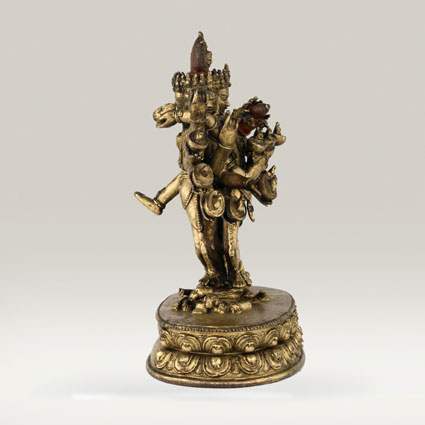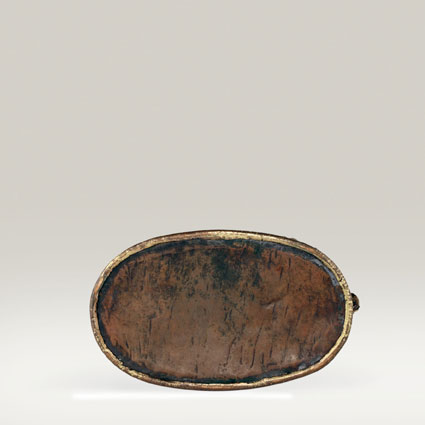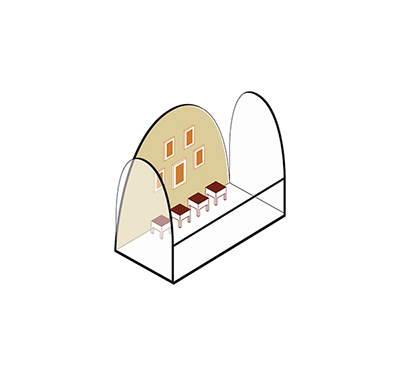ABS 179
Code: ABS 179
Country: Tibet
Style:
Date: 1550 - 1650
Dimensions in cm WxHxD: 12.1 x 15.3 x 7.5
Materials: Gilt copper
This jewelled ornaments are inset with turquoise, many of which are lost.
The bottom of the pedestal is sealed with a plain sheet of copper.
This image depicts the sixteen-armed form of the Yi dam Hevajra with eight faces anf four legs known as Kapaladhara Hevajra (Tib. Thod pa kyai rdo rje), joined with Nairatmya as a pair (yuganaddha). In his eight right hands Hevajra holds skull-cups (kapala) containing small effigies of an elephant, a horse, an ass, an ox, a camel, a man, a lion, and a cat, all acting as guardians of the eighth directions. The skull-cups (kapala) in his left hands contain small effigies of deities, namely Prthivi (earth), Varuna (water), Vayu (air), Tejas (fire), Candra (moon), Aditya or Arka (sun), Yama or Antaka (death), and Dhanada (wealth). The two principal hands of Hevajra, crossed in front of the chest (prajnalinganabhinaya), embrace his consort Nairatmya (Tib. dBag med ma). In her hands she holds a ritual chopper with a vajra handle (vajrakartrika) and a skull-cup (kapala), and has her right leg wrapped around his waist. Both are naked except for the "six ornaments" (sanmudra), respectively "five ornaments" (pancamudra) carved of bone, while he also wears a garland of several heads (mundamala )around his neck.
Hevajra is one of the main yidams in Tibetan Buddhism. This tutelary yidam is described, with all the ceremonies used in his worship as well as his sadhana, in the Hevajra tantra, which figured historically in Drogön Chögyal Phagpa's conversion of the Mongolian emperor Khubilai to Tibetan Buddhism in the thirteenth century A.D.
Iconography
Hevajra has four forms described in the Hevajra Tantra and four forms described the Samputa Tantra:
* Hevajra Tantra
1. Kaya Hevajra
The two-armed Body (Kaya) Hevajra described in the Hevajra Tantra stands in an advancing posture on a multi-coloured lotus, corpse, and sun disk. He is dark blue in colour. His right hand holds a vajra, and his left hand holds a vajra-marked skull cup. He embraces his consort Vajranairatma (rDo-rje bDag-med-ma). A khatvanga staff rests on his left shoulder and he is adorned with the six symbolic ornaments.
In the Sadhanamala 244 this form of Hevajra is single (ekavira) - without a consort.
2. Vak Hevajra
The four-armed Speech (Vak) Hevajra described in the Hevajra Tantra stands in an advancing posture on a multi-coloured lotus, corpse, and sun disk. He is dark blue in colour. One right hand holds a vajra and one left hand a skull full of blood, the other pair of arms embrace his consort Vajravarahi (rDo-rje phag-mo).
3. Citta Hevajra
The six-armed Mind (Citta) Hevajra described in the Hevajra Tantra stands in an advancing posture with right leg extended and left bent on a multi-coloured lotus, corpse, and sun disk. He is dark blue in colour with three faces - C. blue, R. white and L. red. Each face has three blood shot eyes and four bared fangs, and frowns with knotted brows. His tawny hair streams up surmounted with a crossed vajra. Two right hands hold a vajra and a knife, two left a trident and a bell; the remaining pair of arms embrace his consort Vajrasrnkhala Hevajra is imbued with the nine dramatic sentiments and adorned with a diadem of five dry skulls, a necklace of fifty fresh head and the six symbolic ornaments or “seals”.
4. Hrdaya Hevajra
The sixteen-armed, four-legged eight-faced Heart (Hrdaya) Hevajra described in the Hevajra Tantra stands with two legs in ardha-paryanka and the other two in alidha posture (left bent, right extended) on a multi-coloured eight petalled lotus, the four Maras in the forms of yellow Brahma, black Vishnu, white Shiva (Mahesvara) and yellow Indra and a sun disc resting on their hearts.
Sri Hevajra is 16 years old, black in color, naked, with eight faces, sixteen arms and four legs. His central face is black, the first right white, the first left red, the upper face smoke-coloured and ugly; the outer two faces on each side, black. All have three round blood shot eyes, four bared fangs, a vibrating tongue, and frowning with knotted brows. His lustrous tawny hair streams upward crowned with a crossed vajra. He is adorned with a diadem of five dry skulls. The sixteen hands hold sixteen skull cups. The central pair of arms skulls contain a white elephant and the yellow earth-goddess Prithvi and embrace his consort Vajranairatma (rDo-rje bDag-med-ma) whose two legs encircle his body. Her right hands hold a curved knife, while the left is wrapped around the neck of her lord and holds a skull cup. In the other seven skull cups held in Hevajra's outer right hands are: a blue horse, a white-nosed ass, a red ox, an ashen camel, a red human, a blue sarabha deer, and an owl or cat. In the skull cups in the outer seven left hands are the white water-god Varuna, the green wind-god Vayu, the red fire-god Agni / Tejas, the white moon god Candra, the red sun god Surya or Aditya, blue Yama lord of death and yellow Kubera or Dhanada lord of wealth. Hevajra is adorned with the six symbolic ornaments: circlet, earrings, necklace, bracelets, girdle armlets and anklets and smeared with the ashes of the charnel ground. He wears a necklace of fifty freshly severed human heads.
* Samputa Tantra
The four forms of Hevajra described in the Samputa Tantra all dance on a lotus, corpse, blood-filled skull cup and sun disk throne.
1. Kaya Hevajra
The two-armed Kaya-Hevajra (sku kyE rdo rje) - "Shaker of all the Three Worlds" ('jig-rten gsum kun-tu bskyod-pa) – stands in dancing posture on a multi-coloured lotus, corpse, blood-filled skull cup and sun disk. He is black in colour, with one face, three round red eyes, and two arms. His right hand wields a five-pronged vajra club and the left hand holds a skull cup brimming with blood. He embraces his consort Vajranairatma (rdo-rje bdag-med-ma), blue in colour, with one face and two arms, holding curved knife and skull cup.
2. Vak Hevajra
The four-armed Vak-Hevajra (sung kyE rdo rje), stands in dancing posture on a multi-coloured lotus, corpse, blood-filled skull cup and sun disk. He is black in colour with one face, three round red eyes two legs and four arms. The outer right hand wields a five-pronged vajra club, the outer left hand holds a blood-filled skull-cup; the other pair of arms embrace his consort Vajravarahi (rDo-rje phag-mo), who is similar to him.
3. Citta Hevajra
The six-armed Citta-Hevajra (thugs kyE rdo rje) stands in dancing posture (ardha paryanka) with his right toenails pressed against his left thigh on an eight-petaled multi-coloured lotus, corpse, skull-cup brimming with blood, and sun disc. He is black, with three faces: black, white and red - each face having three round blood shot eyes. His light yellowish hair streams upwards crested with a crossed vajra, and he wears a diadem of five dry skulls. He is adorned with a necklace of fifty freshly severed human heads, the six symbolic ornaments and clad in a tiger skin skirt. The first pair of hands hold a vajra and bell embracing is consort Vajrasrnkhala, who is similar to him. The other right hands hold an arrow and a trident. The other left hands hold a bow and a skull cup.
4. Hrdaya Hevajra
The sixteen armed four legged Hrdaya Hevajra (snying po kyE rdo rje) stands with two legs in dancing posture (ardha paryanka) and two in aleedha posture (right leg extended) on an eight-petalled multicoloured lotus are, the four Maras (Skanda Mara in the form of yellow Brahma, Klesa Mara as black Vishnu, Mrtyu Mara as white Shiva, Devaputra Mara as pale yellow Sakra), a blood filled skull-cup and sun disc. He is black in colour with eight faces, sixteen arms and four legs. The central face is black and laughing loudly, the right is white, and the left is red, and the upper face black and bears its fangs; the other eight faces are black. Each face has three blood-shot eyes. His tawny hair flows upwards crested with a double vajra and he wears a diadem of five dry skulls. He is adorned with a necklace of fifty freshly severed human heads, the six symbolic ornaments and clad in a tiger skin skirt. His first pair of hands hold a vajra and bell, embracing his consort Nairatma blue in colour with two hands holding a curved knife (gri gug) and skull cup. Hevajra's remaining right hands hold a sword, arrow, wheel, skull cup, club, trident and hook; the remaining left hands hold a lotus, bow, trident, skull, jewel, threatening forefinger and noose.
References
* Chandra, Lokesh (2002). Dictionary of Buddhist Iconography Delhi: Aditya Prakashan.
* Farrow, G.W. & Menon I. (1992). The Concealed Essence of the hevajra-tantra Delhi: Motilal Banarasidas.
* Pott, P.H. (1969). The Mandala of Heruka in CIBA Journal No. 50, 1969.
* Snellgrove, D.L. (1959). The Hevajra Tantra: A Critical Study (London Oriental Series, Vol. 6) London: Oxford University Press.
Bhattacharyya, Benoytosh , 1958. Indian Buddhist Iconography. Calcutta: K. L. Mukhopadhyay. Pp. 157-159 - References to the iconography of Hevajra / Badrapadra. Srihevajravyavivarana.
Chandra, Lokesh, 2002. Dictionary of Buddhist Iconography (15 volumes). Delhi: Aditya Prakashan.
de Mallmann, Marie-Thérèse, 1975. Introduction à l'iconographie du tântrisme bouddhique. Paris: Adrien Mainsonneuve (Jean Maisonneuve successeur (1970). Pp. 182-187 - References to the iconography of Hevajra / Badrapadra. Srihevajravyavivarana.
Farrow, George W. and Menon, I., 1992. The Concealed Essence of the hevajra-tantra . Delhi: Motilal Banarasidas.
Pott, Pieter H. , 1969. The Mandala of Heruka, in CIBA Journal No. 50. CIBA Journal No. 50.
Sèngué, Tcheuky, 2002. Petite Encyclopédie des Divinités et symboles du Bouddhisme Tibétain. Editions Claire Lumiere . Pp. 214-217 - Références françaises: Hevajra
Snellgrove, David L., 1959. The Hevajra Tantra: A Critical Study, Part 1: Introduction and Translation; Part 2: Sanskrit and Tibetan Texts, London Oriental Series. Vol. 6, Parts 1 & 2.. London: Oxford University Press. References to the iconography of Hevajra / Badrapadra. Srihevajravyavivarana.






